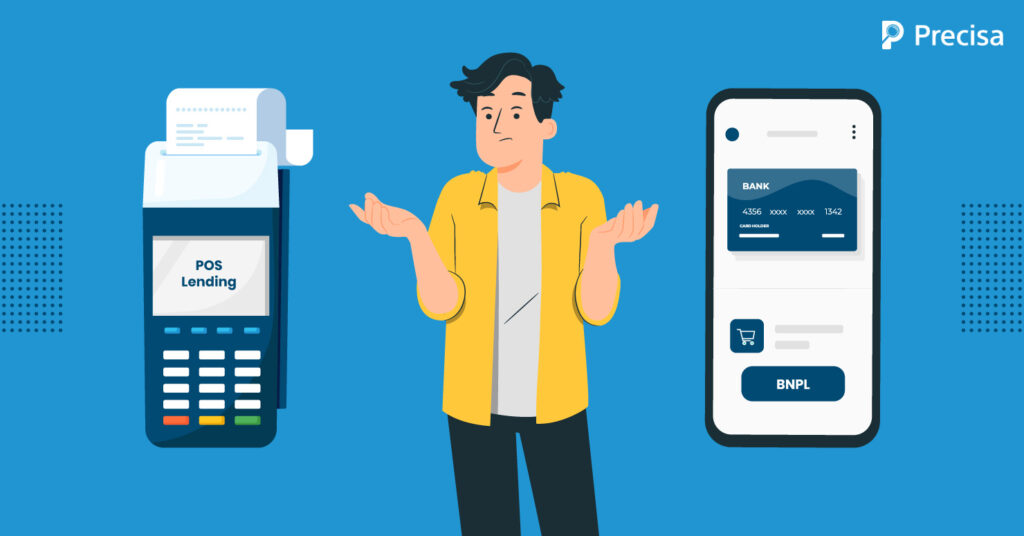How is BNPL Different from POS Lending? An Overview

With growing digitisation, the fillip online shopping received during the pandemic and popularity among the youth have encouraged the Point of Sale (POS) financing options. The most common form of POS financing is Buy Now, Pay Later (BNPL)
It is interest-free credit where consumers spread the cost of an item over a short period. Many customers prefer buying a product or service immediately and paying later over several instalments, making BNPL a suitable choice.
BNPL services are gradually gaining popularity in the Indian market. The transaction value is estimated to grow at a compound annual growth rate (CAGR) of 32.5% between 2022 to 2026 to reach Rs 1.1 trillion in 2026, as per GlobalData .
In this blog, let us explore the difference between the finance options.
What Is POS Lending?

Point of sale lending is a broad term for all forms of credit available to shoppers for flexible, pay-in-instalments-over-time options. Consumers may opt for a one-time credit at checkout to break their payment into small monthly instalments.
Alternatively, the customer can sign-up with a payment platform that has a tie-up with specific retailers and gives the customer an option to choose a payment plan at checkout.
What Are BNPL Services?
As the term suggests, Buy now, pay later (BNPL) services allow the buyer purchases a product and takes it home while paying for it later.
The buyer makes an instant purchase; the BNPL service provider settles the bills with the retailer or service provider, and the buyer repays the amount with little or no interest.
Therefore, BNPL can be considered a short-term loan that offers an attractive payment option for consumers.
BNPL and POS: How Are They Related?
Usually, BNPL and POS are used interchangeably. BNPL is often used to describe all financing options available at the point of sale. All BNPL services are a form of POS financing, but not all POS financing is a form of BNPL.
- Point-of-sale financing, which excludes BNPL, is available to customers at the same stage, at the time of payment; they include instalment loans and lines of credit.
- Both BNPL and POS lending are financing options that help customers expand their financial means and purchase products they would not have been able to buy otherwise.
- Both financing alternatives disburse funds directly to the retailer, letting consumers pay off the purchase price over the stipulated time.
At the same time, in common parlance, POS lending refers to bigger-ticket credit for a longer duration, while BNPL options are available for small-ticket purchases and are for a shorter term.
8 Differences Between POS Lending And BNPL
Even though POS lending and BNPL are used synonymously, there are a few subtle differences between them.
1. Ticket Size
BNPL is usually used for smaller purchases, while POS lending is for larger ticket-size purchases.
2. Repayment
Point-of-sales repayment can stretch over the years, compared to BNPL instalments that run for 4 to 12 months.
3. Interest Rate
BNPL services are interest-free, unlike POS lending, where the customer has to pay interest. In the latter option, there might be some interest-free periods, depending on the lender.
4. Retailers Offering BNPL And POS Lending
Generally, consumers make big-ticket purchases using the POS lending option. Smaller retailers selling personal goods and clothing are less likely to offer BNPL, while appliance and furniture sellers will offer POS lending.
5. Credit Check
When a consumer applies for BNPL credit, the lender carries out no credit check or does a soft credit check that does not impact the customer’s credit score. In POS lending, credit checks and underwriting are required; the lender makes a hard inquiry.
6. Downpayment
When customers use the BNPL facility, they may have to make a small down payment varying from one retailer to another, usually 25% of the entire amount.
7. Flexibility
Compared to BNPL, POS lending is less flexible. Some BNPL providers allow customers to choose payment frequency, but this choice is not available in the latter option.
8. Time Taken for Approval
BNPL credit approvals are on the spot, and the customer does not have to wait; POS lending approvals may take longer.
POS or BNPL: How to Choose?
From the retailers’ perspective, both POS lending and BNPL services offer the potential to boost conversions and sales, leading to growth in business. Merchants benefit from higher acquisitions as more customers are drawn into the fold due to the easy availability of finance. Moreover, they get paid instantly and also gain a competitive advantage.
Lenders need to be aware of their target audience and offer them a solution that is most viable for them and allows the consumer to repay the dues promptly without burdening them too much.
Though customers might not be interested in splitting hairs about the jargon, they should know the terms, and applicable charges, even if it has zero interest, and also be aware that non-payment or delay in payment has consequences.
Irrespective of the lending option, all stakeholders must choose affordability, suitability, and accountability to be part of the discussion.
The Takeaway
Implementing a BNPL program or POS finance system requires a robust technology infrastructure, which has features like assessing customer creditworthiness assessment, integration with multiple payment providers and retailers and reconciliation and more.
This is why the fintech platform Precisa offers solutions like the cutting-edge bank statement analyser tool and others that help businesses make this transition smooth.
If you are looking for solutions that help you be a part of the BNPL and POS growth journey, call for a demo now!


